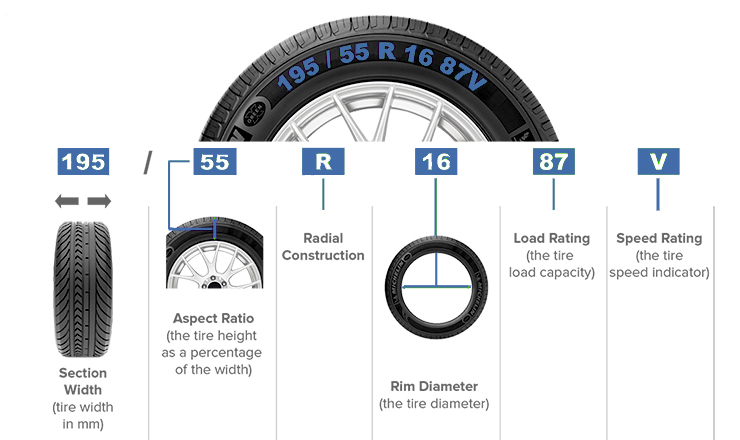Tire changing is something that all car owners will encounter when using their car. This is a very common vehicle maintenance process, but it is very important to our driving safety.
So what do you need to pay attention to when changing tires to avoid unnecessary trouble? Let’s talk about some guides for changing tires.
1. Don’t Get The Tire Size Wrong
Confirming the size of the tire is the very first step to do the job. The specific parameters of this tire are engraved on the sidewall of the tire. You can choose a new tire of the same size according to the parameters on the original tire.
Car wheels generally use radial tires. The specifications of radial tires include width, aspect ratio, inner diameter and speed limit symbol.
Take above photo as an example. Its tire specification is 195/55 R16 87V, which means that the width between the two sides of the tire is 195 mm, 55 means the aspect ratio, and “R” stands for the word RADIAL, which means it is a radial tire. 16 is the inner diameter of the tire, measured in inches. 87 indicates the tire load capacity, which is equivalent to 1201 pounds. Some tires are also marked with speed limit symbols, using P, R, S, T, H, V, Z and other letters to represent each speed limit value. V means the maximum speed is 240km/h(150MPH)
2. Install The Tire Correctly
Nowadays, many tire patterns are asymmetrical or even directional. So there is a problem of directionality when installing tires. For example, an asymmetric tire will be divided into inside and outside patterns, so if the inner and outer sides are reversed, the performance of the tire is not the best.
In addition, some tires have a single guide–that is, the direction of rotation is specified. If you reverse the installation, it may be no problem if we open it normally, but if there is a wetland situation, its drainage performance will not be able to fully play. If the tire uses a symmetrical and non-single-conducting pattern, you don’t need to consider the inside and outside, just install it at will.
3. Do All Tire Patterns Have To Be The Same?
Usually we will encounter this situation where one tire needs to be replaced, but the other three do not need to be replaced. Then someone will ask, “If the pattern of my tire that needs to be replaced is different from the other three patterns, will it affect the driving?”
In general, as long as the grip level (ie traction) of the tire you change is the same as your original tire, there is a high probability that there will be no impact. But one thing to note is that in rainy weather, tires with different designs and patterns will have different drainage performance and different grip on wet ground. So if you are braking, it is possible that your left and right wheels can get different grip. Therefore, it may be necessary to reserve a longer braking distance in rainy days.
4. Wrong Steering Feel After Changing Tires?
Some people feel that the steering feel suddenly becomes lighter after changing the tires. Is there something wrong?
Of course not! Because the surface of the tire is still very smooth when the tire is just put on, it does not have enough contact with the road, so there is not much steering resistance that we usually drive. But when your tire is used and its tread is worn away, its contact with the road will become tighter, and the familiar steering feel will return.
5. Correct Tire Pressure Matters
We know that the lower the tire pressure, the more comfortable the ride will be; the higher the tire pressure, the more bumpy it will be. There are also people who worry that too high a tire pressure will easily cause a puncture, but in fact, all cases show that if a car punctures due to the tire pressure, it can only be because the tire pressure is too low and not too high. Because the pressure that a car’s tire can withstand is at least three atmospheres upwards, even if you hit 2.4-2.5bar, or even 3.0bar, the tire will not blow out.
For general urban driving, the recommended tire pressure is between 2.2-2.4bar. If you need to drive on the highway and the speed is expected to be relatively fast, you can hit 2.4-2.5bar in the cold tire state, so you don’t have to worry about low tire pressure and puncture when running at high speed.
Post time: Sep-17-2021






